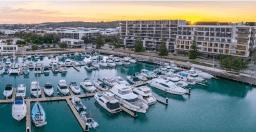The Walk of Life
How walkable communities are the key to healthier, happier, and more prosperous cities.

Words: Tod O'Dwyer, General Manager of Development and Design, Frasers Property Australia
In the development community we talk a lot about creating places that are walkable; where getting from one side of the neighbourhood to another can be done without needing the use of a car. Most of the time, the explicit benefits centre on convenience and safety. Convenience because what you need is just a stroll away. Safety because streets aren’t as clogged with cars, which is great for pedestrians and the environment.
While these advantages are obviously important, we’re increasingly learning that walkable communities offer a range of other benefits - including living a longer and healthier life.
As most of us know by now, two of the biggest health problems facing western societies today are obesity and loneliness. Studies show that social isolation and loneliness can increase our risk of premature death by 26%, while obesity increases the risk and severity of almost every disease you can think of - from diabetes to cancer, as well as dementia, stroke, and arthritis.
The good news is that one of the most natural places to begin is movement. There’s compelling evidence that the healthiest and longest-living people in the world all share something in common: they actually don’t go out of their way to find exercise, they simply walk to go about their daily lives. In other words, the exercise is incidental to their routine – but it’s there and it’s helping to keep them fit without having to really think about it.
For urban designers like me, this incidental exercise insight has helped to elevate our thinking and spurred us on to find creative ways to making walkability a natural part of the communities we design.
Mixed-use living
Perhaps the biggest single contribution that we can make to healthier, more human-scale cities is to design for mixed use. Places that don’t just cater for purely one thing but instead support shops and schools and entertainment and recreation all in close range.
It only takes 22 minutes of walking every day to get the minimum movement recommended by health professionals, and what’s easier than incidentally getting that exercise strolling down to the local pool, library, supermarket, bus stop or train station, school, park, netball courts, and so on? The point is, if it’s reasonably close, you’ll walk to it.
Perhaps best of all, because you’re less likely to use your car, you have a much greater chance of socially interacting with your neighbours. A nod here, a smile there, stopping to pet a dog or chat with the family down the street are great for the heart and soul, creating stronger social links that are the fabric of community life.
Walking the walk
Speaking of human-scale, another vital ingredient in the walkable community is focusing imaginatively and thoughtfully on the experience of people. What can you do to make the walk more than just a walk? Landscaping for shade so people don’t tire out so fast on hot days; street furniture like benches for resting on; urban art or street art for scenic inspiration; cross-walks and kerb ramps that are safe for children, the elderly, and disabled are just some of the ways you can begin to create places that are welcoming to walkers.
Healthier and...wealthier?
One of the more surprising outcomes of creating more walkable communities is economic value. In much the same way that suburbs with low crime statistics command higher property prices, so too do suburbs with high walk scores. A 2009 study by CEOs for Cities in the U.S found that for every additional one-point increase in Walk Score there was an associated increase in home values of between $500 and $3,000. Walkability isn’t just good for us, it’s also highly desirable.
The best thing about designing walkability into new community development is that it gives us urban designers and developers permission to be imaginative. If we want safer streets, an end to dormitory suburbs, healthier and prosperous populations then a great place to start is walkability. It’s been the foundational principle for projects as diverse as Burwood Brickworks in Melbourne’s east, Ed Square in Sydney’s south-west, and Brookhaven in Queensland: walkable communities that are on the right path for solving all manner of social problems for generations to come.
New edition out now - Live Proud Spring/Summer 2019. This latest edition tells the story of our 95 year history of creating communities in Australia, as well as many more customer stories. We hope you enjoy the read.
Read the Live Proud magazine here

